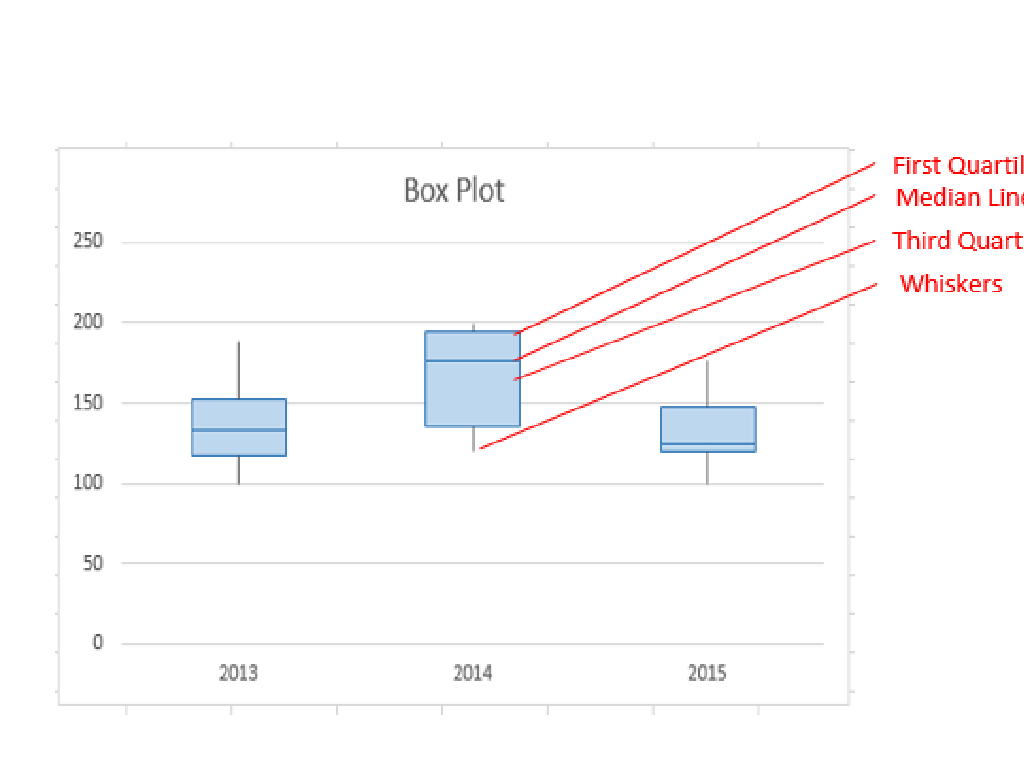Interpret Line Graphs
Subject: Math
Grade: Eighth grade
Topic: Two-Variable Statistics
Please LOG IN to download the presentation. Access is available to registered users only.
View More Content
Interpreting Line Graphs in Two-Variable Statistics
– Two-variable statistics overview
– Explore how two sets of data relate to each other
– Data’s role in understanding the world
– Data helps us make sense of trends and patterns
– Defining two-variable statistics
– It involves analyzing pairs of numerical data
– Today’s focus: Line graphs
– Learn to read and interpret data from line graphs
|
This slide introduces students to the concept of two-variable statistics, emphasizing the importance of data in interpreting the world around us. Two-variable statistics involve analyzing pairs of numerical data to understand the relationship between them. Today’s lesson will focus on line graphs, a powerful tool for visualizing data trends over time or across categories. Students will learn how to read line graphs, understand the significance of the x and y-axes, and interpret the meaning of the data points and the slope of the line. Encourage students to think about how line graphs are used in various real-life situations, such as tracking changes in temperature over a week or comparing the growth of different plants over time.
Understanding Line Graphs
– Line graph basics
– A graph with points connected by lines to show data
– Visualizing changes over time
– Track variables like time, temperature, or prices
– Common uses of line graphs
– Often used in weather, economics, and science
– Recognizing trends and patterns
– Look for upward, downward, or constant trends
|
A line graph is a type of chart used to show information that changes over time. We plot data points on the graph and connect them with lines to visualize how the values have changed. This is particularly useful in subjects like science to track temperature changes, in economics to show changes in stock prices, or in social studies to illustrate population growth. When interpreting line graphs, students should look for trends such as increases, decreases, or periods where the values remain constant. Encourage students to discuss what these trends might mean in real-world scenarios and to consider why understanding these patterns is important.
Understanding Line Graph Components
– Significance of X-axis and Y-axis
– X-axis typically shows time, while Y-axis shows what is being measured.
– Data Points: Graph ‘dots’
– Each ‘dot’ represents a data value at a specific point.
– Lines: Visualizing trends
– Lines connect the dots, illustrating the relationship between variables over time.
– Interpreting the graph’s story
|
This slide aims to break down the fundamental components of a line graph, which is a crucial tool in two-variable statistics. Students should understand that the X-axis often represents time and the Y-axis represents the variable being measured, such as temperature, price, or population. Data points are plotted on the graph where the X and Y values meet, and these points are connected by lines to show the trend or how the data changes over time. Encourage students to think of the line graph as telling a story about the data, where they can interpret the trends and make predictions based on the information presented. Provide examples of line graphs for students to analyze in class.
Interpreting Line Graphs
– Identify axes variables
– X-axis and Y-axis represent different variables, such as time and temperature.
– Analyze the trend
– Is the line going up, down, or staying level?
– Observe patterns and changes
– Look for repeated behavior or shifts in the graph’s direction.
– Discuss graph insights
– What does the graph tell us about the relationship between the variables?
|
This slide aims to teach students how to read and interpret line graphs, a key skill in understanding two-variable statistics. Start by identifying the variables represented on the X-axis (horizontal) and Y-axis (vertical). Discuss how to analyze the graph’s trend, whether it’s increasing, decreasing, or constant over time. Encourage students to observe any patterns, spikes, or drops that could indicate important changes or behaviors. Finally, facilitate a discussion on what insights can be drawn from the graph, such as correlations or causations between the variables. Provide examples of line graphs for students to practice these skills.
Interpreting Line Graphs
– Understanding the slope
– Slope indicates rate of change over time
– Analyzing peaks and valleys
– Peaks represent highs, valleys are lows
– Stock Market Trends example
– How stock prices change over time
– Drawing conclusions from graphs
|
This slide aims to help students grasp how to interpret line graphs by understanding the significance of the slope and what it can reveal about the data being represented. The slope of a line graph is crucial as it shows the rate at which one variable changes in relation to another. Peaks and valleys on the graph are key indicators of maximum and minimum points that can be analyzed to understand trends. Using the stock market as a real-life example, students can see how line graphs are used to track the fluctuation of stock prices over time. Encourage students to look at various line graphs and practice drawing conclusions based on the slope, peaks, and valleys they observe.
Let’s Practice: Interpreting Line Graphs
– Analyze ‘Hours Studied vs. Test Scores’
– Correlation of study time and scores
– Does more study time lead to higher scores?
– Predict score for 5 hours of study
– Use the graph’s trend to estimate
– Discuss graph trends and patterns
– Look for upward, downward, or steady trends
|
This slide is an interactive class activity designed to help students apply their knowledge of interpreting line graphs. Present a line graph that plots ‘Hours Studied’ on the x-axis against ‘Test Scores’ on the y-axis. Ask students to observe the relationship between the amount of time spent studying and the scores achieved. Encourage them to think critically about whether an increase in study hours generally results in higher test scores. Then, challenge them to use the graph to predict what score might be expected if a student studies for 5 hours. Discuss how to identify and interpret trends and patterns in the graph. Possible activities include: 1) Group discussion on graph interpretation, 2) Individual predictions followed by group consensus, 3) Creating a similar graph with class data, 4) Role-playing a scenario where students explain the graph to a peer, 5) Writing a brief report on their findings and predictions.
Class Activity: Create Your Line Graph
– Pair up and pick a topic
– Collect and organize your data
– Record data points over a period of time
– Plot your data on a line graph
– Use a ruler for straight lines and even spacing
– Present your graph and findings
– Explain the trend your graph shows
|
This activity is designed to provide hands-on experience with line graphs. Students should work in pairs to foster collaboration. They can choose a topic that interests them, such as tracking daily temperatures or monitoring an exercise routine over a week. Encourage them to collect data methodically and organize it in a table before plotting it on the graph. Emphasize the importance of scale and intervals on the graph for accuracy. Once completed, each pair will present their graph to the class, explaining the data they collected and any trends or patterns observed. This will help them understand how line graphs can be used to interpret real-world data. Possible variations for different pairs could include tracking study hours, water intake, or even the number of steps walked per day.
Conclusion: The Value of Line Graphs
– Significance of line graphs
– They show trends and changes over time clearly.
– Line graphs in real life
– Useful for budgeting, tracking progress, or forecasting weather.
– Class discussion on learnings
– Share insights and applications discovered.
|
This slide aims to wrap up the lesson by emphasizing the importance of line graphs in data interpretation. Highlight how line graphs allow us to visualize trends and changes over time, making complex data more accessible. Discuss real-life applications, such as budget tracking, academic progress, or weather prediction, to solidify understanding. Conclude with a class discussion, prompting students to reflect on and share what they’ve learned. Encourage them to think about how they can apply these skills outside the classroom. This will help reinforce the day’s lessons and give students a sense of practical application.





